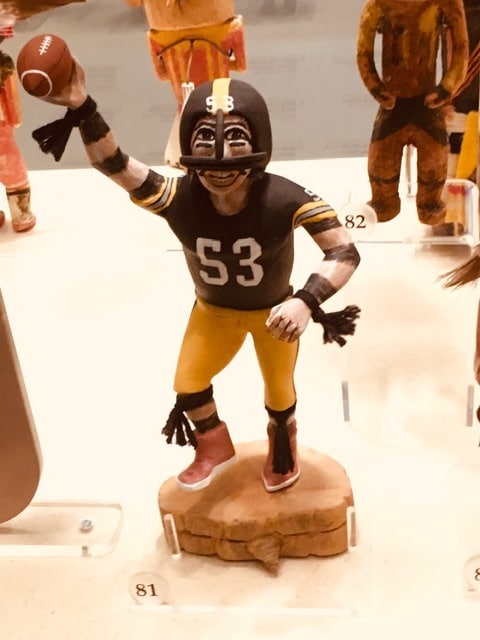
A celebratory touchdown dance in carved cottonwood has been quietly occurring at Carnegie Museum of Natural History for more than 22 years. Within the Alcoa Foundation Hall of American Indians, in the quadrant of the exhibition devoted to conveying information about the Hopi and their culture, a nine-inch high figure of a Pittsburgh Steelers player wearing number 53 holds a football aloft in his right hand. The wide-eyed grinning figure is displayed with plenty of colorful company, and its significance is best understood in terms of this carefully assembled cast.
The carved figures, which are properly called tihus, and more frequently referred to as katsinas, represent the benevolent spirit beings who live among the Hopi on three high mesas of northern Arizona for approximately a six-month period each year. An important role for the carvings is the imparting of knowledge and understanding of these beings or katsinam, and the target audiences for these life lessons are the Hopi themselves.
This aspect of limited cultural sharing was explained to museum educators in the months before the exhibition hall opened in 1998 when Hartman Lomawaima, a Hopi consultant, conducted a training session about the carvings. After a 90-minute presentation that included information about how the katsinas displayed in the hall had not been used in sacred ceremonies, he fielded a particularly pertinent question. “When we take students through the hall we won’t have the time you’ve just shared with us,” explained an experienced interpreter. “What can we tell students about these figures in a minute or two?” “That’s easy,’’ replied Hartman, “just tell them they’re three-dimensional prayers.”
A little more information about the black and gold figure can be gleaned from exhibit text. Here the carving is described as PITTSBURGH STEELER CLOWN KOYAALA, the carver identified as Regina Naha, and the creation date listed as 1992. A reputable reference on katsinas describes the word “Koyaala” as referring to clown figures of the village of Hano on First Mesa, and an internet search under the artist’s name reveals that she is from Hano.
For Steeler fans, and perhaps even for the team’s players, coaches, and administrators, there might be small comfort in knowing a “three-dimensional” prayer clad in their team’s uniform resides under the same roof as Tyrannosaurus rex. For fans of the city itself, the story of how the carving came to be on display offers another example of Pittsburgh Pride. In a font smaller than the rest of the display’s text, the figure is noted to be a “gift of Les and Joan Becker.” Deborah Harding, Collection Manager in the museum’s Section of Anthropology, was able to share some information about the couple. “Les and Joan were long-time and valuable volunteers in this section. During a visit to Arizona they spotted the Steeler carving in the shop at The Heard Museum in Phoenix, and bought it for the museum with the approval of the curator directing the hall’s development. According to the story I heard, Les was able to barter for a lower price by arguing that the figure would be displayed where it belonged, in Pittsburgh.”
Patrick McShea works in the Education and Visitor Experience department of Carnegie Museum of Natural History. Museum employees are encouraged to blog about their unique experiences and knowledge gained from working at the museum.
